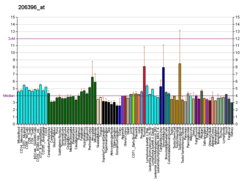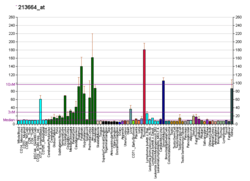Excitatory amino acid transporter 3
Excitatory amino acid transporter 3 (EAAT3), is a protein that in humans is encoded by the SLC1A1 gene.[5][6]
Tissue distribution
EAAT3 is expressed on the plasma membrane of neurons, specifically on the dendrites and axon terminals.[7]
Function
Excitatory amino acid transporter 3 is a member of the high-affinity glutamate transporters which plays an essential role in transporting glutamate across plasma membranes in neurons. In the brain, excitatory amino acid transporters are crucial in terminating the postsynaptic action of the neurotransmitter glutamate, and in maintaining extracellular glutamate concentrations below neurotoxic levels. EAAT3 also transports aspartate, and mutations in this gene are thought to cause dicarboxylic aminoaciduria, also known as glutamate-aspartate transport defect.[6] EAAT3 is also the major route of neuronal cysteine uptake. Cysteine is a component of the major antioxidant glutathione, and mice lacking EAAT3 exhibit reduced levels of glutathione in neurons, increased oxidative stress, and age-dependent loss of neurons, especially neurons of the substantia nigra. A meta-analysis identified a small but significant association between a polymorphism of the gene SLC1A1 and Obsessive-Compulsive Disorder.[8]
Interactions
SLC1A1 has been shown to interact with ARL6IP5.[9]
See also
- Excitatory amino acid transporter
- Glutamate transporter
- Solute carrier family
References
- GRCh38: Ensembl release 89: ENSG00000106688 - Ensembl, May 2017
- GRCm38: Ensembl release 89: ENSMUSG00000024935 - Ensembl, May 2017
- "Human PubMed Reference:". National Center for Biotechnology Information, U.S. National Library of Medicine.
- "Mouse PubMed Reference:". National Center for Biotechnology Information, U.S. National Library of Medicine.
- Smith CP, Weremowicz S, Kanai Y, Stelzner M, Morton CC, Hediger MA (March 1994). "Assignment of the gene coding for the human high-affinity glutamate transporter EAAC1 to 9p24: potential role in dicarboxylic aminoaciduria and neurodegenerative disorders". Genomics. 20 (2): 335–6. doi:10.1006/geno.1994.1183. PMID 8020993.
- "Entrez Gene: SLC1A1 solute carrier family 1 (neuronal/epithelial high affinity glutamate transporter, system Xag), member 1".
- Underhill SM, Wheeler DS, Li M, Watts SD, Ingram SL, Amara SG (July 2014). "Amphetamine modulates excitatory neurotransmission through endocytosis of the glutamate transporter EAAT3 in dopamine neurons". Neuron. 83 (2): 404–416. doi:10.1016/j.neuron.2014.05.043. PMC 4159050. PMID 25033183.
In general, EAATs 1 and 2 are found predominantly in astrocytes, EAAT3 in neurons, EAAT4 in Purkinje cells, and EAAT5 expression is restricted to the retina (Danbolt, 2001). The dependence of EAAT3 internalization on the DAT also suggests that the two transporters might be internalized together. We found that EAAT3 and DAT are expressed in the same cells, as well as in axons and dendrites. However, the subcellular co-localization of the two neurotransmitter transporters remains to be established definitively by high resolution electron microscopy.
- Stewart SE, Mayerfeld C, Arnold PD, Crane JR, O'Dushlaine C, Fagerness JA, et al. (June 2013). "Meta-analysis of association between obsessive-compulsive disorder and the 3' region of neuronal glutamate transporter gene SLC1A1" (PDF). American Journal of Medical Genetics. Part B, Neuropsychiatric Genetics. 162B (4): 367–79. doi:10.1002/ajmg.b.32137. hdl:2027.42/98412. PMID 23606572.
- Lin CI, Orlov I, Ruggiero AM, Dykes-Hoberg M, Lee A, Jackson M, Rothstein JD (March 2001). "Modulation of the neuronal glutamate transporter EAAC1 by the interacting protein GTRAP3-18". Nature. 410 (6824): 84–8. Bibcode:2001Natur.410...84L. doi:10.1038/35065084. PMID 11242046.
Further reading
- Nieoullon A, Canolle B, Masmejean F, Guillet B, Pisano P, Lortet S (August 2006). "The neuronal excitatory amino acid transporter EAAC1/EAAT3: does it represent a major actor at the brain excitatory synapse?". Journal of Neurochemistry. 98 (4): 1007–18. doi:10.1111/j.1471-4159.2006.03978.x. PMID 16800850.
- Arriza JL, Fairman WA, Wadiche JI, Murdoch GH, Kavanaugh MP, Amara SG (September 1994). "Functional comparisons of three glutamate transporter subtypes cloned from human motor cortex". The Journal of Neuroscience. 14 (9): 5559–69. doi:10.1523/jneurosci.14-09-05559.1994. PMC 6577102. PMID 7521911.
- Shashidharan P, Huntley GW, Meyer T, Morrison JH, Plaitakis A (October 1994). "Neuron-specific human glutamate transporter: molecular cloning, characterization and expression in human brain". Brain Research. 662 (1–2): 245–50. doi:10.1016/0006-8993(94)90819-2. PMID 7859077.
- Kanai Y, Stelzner M, Nussberger S, Khawaja S, Hebert SC, Smith CP, Hediger MA (August 1994). "The neuronal and epithelial human high affinity glutamate transporter. Insights into structure and mechanism of transport". The Journal of Biological Chemistry. 269 (32): 20599–606. PMID 7914198.
- Zerangue N, Kavanaugh MP (June 1996). "Interaction of L-cysteine with a human excitatory amino acid transporter". The Journal of Physiology. 493 (Pt 2): 419–23. doi:10.1113/jphysiol.1996.sp021393. PMC 1158927. PMID 8782106.
- Bar-Peled O, Ben-Hur H, Biegon A, Groner Y, Dewhurst S, Furuta A, Rothstein JD (December 1997). "Distribution of glutamate transporter subtypes during human brain development". Journal of Neurochemistry. 69 (6): 2571–80. doi:10.1046/j.1471-4159.1997.69062571.x. PMID 9375691.
- He Y, Janssen WG, Rothstein JD, Morrison JH (March 2000). "Differential synaptic localization of the glutamate transporter EAAC1 and glutamate receptor subunit GluR2 in the rat hippocampus". The Journal of Comparative Neurology. 418 (3): 255–69. doi:10.1002/(SICI)1096-9861(20000313)418:3<255::AID-CNE2>3.0.CO;2-6. PMID 10701825.
- Lin CI, Orlov I, Ruggiero AM, Dykes-Hoberg M, Lee A, Jackson M, Rothstein JD (March 2001). "Modulation of the neuronal glutamate transporter EAAC1 by the interacting protein GTRAP3-18". Nature. 410 (6824): 84–8. Bibcode:2001Natur.410...84L. doi:10.1038/35065084. PMID 11242046.
- Veenstra-VanderWeele J, Kim SJ, Gonen D, Hanna GL, Leventhal BL, Cook EH (March 2001). "Genomic organization of the SLC1A1/EAAC1 gene and mutation screening in early-onset obsessive-compulsive disorder". Molecular Psychiatry. 6 (2): 160–7. doi:10.1038/sj.mp.4000806. PMID 11317217.
- Borre L, Kavanaugh MP, Kanner BI (April 2002). "Dynamic equilibrium between coupled and uncoupled modes of a neuronal glutamate transporter". The Journal of Biological Chemistry. 277 (16): 13501–7. doi:10.1074/jbc.M110861200. PMID 11823462.
- González MI, Bannerman PG, Robinson MB (July 2003). "Phorbol myristate acetate-dependent interaction of protein kinase Calpha and the neuronal glutamate transporter EAAC1". The Journal of Neuroscience. 23 (13): 5589–93. doi:10.1523/jneurosci.23-13-05589.2003. PMC 6741220. PMID 12843260.
- Noorlander CW, de Graan PN, Nikkels PG, Schrama LH, Visser GH (July 2004). "Distribution of glutamate transporters in the human placenta". Placenta. 25 (6): 489–95. doi:10.1016/j.placenta.2003.10.018. PMID 15135231.
- Koch HP, Larsson HP (February 2005). "Small-scale molecular motions accomplish glutamate uptake in human glutamate transporters". The Journal of Neuroscience. 25 (7): 1730–6. doi:10.1523/JNEUROSCI.4138-04.2005. PMC 6725926. PMID 15716409.
- Vallejo-Illarramendi A, Domercq M, Pérez-Cerdá F, Ravid R, Matute C (January 2006). "Increased expression and function of glutamate transporters in multiple sclerosis". Neurobiology of Disease. 21 (1): 154–64. doi:10.1016/j.nbd.2005.06.017. PMID 16061389.
- Rual JF, Venkatesan K, Hao T, Hirozane-Kishikawa T, Dricot A, Li N, et al. (October 2005). "Towards a proteome-scale map of the human protein-protein interaction network". Nature. 437 (7062): 1173–8. Bibcode:2005Natur.437.1173R. doi:10.1038/nature04209. PMID 16189514.
- Rainesalo S, Keränen T, Saransaari P, Honkaniemi J (November 2005). "GABA and glutamate transporters are expressed in human platelets". Brain Research. Molecular Brain Research. 141 (2): 161–5. doi:10.1016/j.molbrainres.2005.08.013. PMID 16198020.
This article incorporates text from the United States National Library of Medicine, which is in the public domain.





